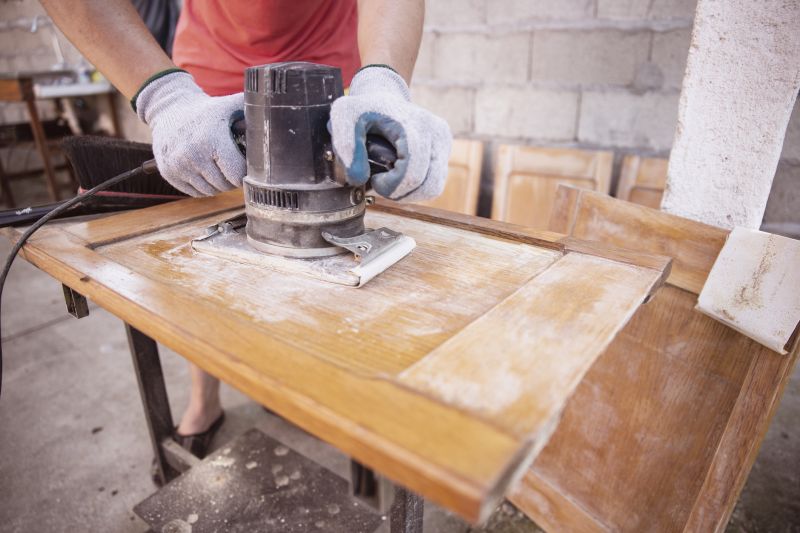Popular Door Refinishings Products For a Fresh New Look
Find the most sought-after supplies to revitalize your doors and add style to any room effortlessly.
 Refinishing a door can dramatically enhance the appearance of a room and extend the lifespan of the door itself. Whether you are restoring an antique or updating a modern interior, selecting the right products is essential for achieving a smooth, durable, and professional-looking finish. The process typically involves surface preparation, application of primer or stain, and finishing with protective coatings. Proper tools and materials ensure that the refinishing project results in a clean and even surface, free from imperfections.
Refinishing a door can dramatically enhance the appearance of a room and extend the lifespan of the door itself. Whether you are restoring an antique or updating a modern interior, selecting the right products is essential for achieving a smooth, durable, and professional-looking finish. The process typically involves surface preparation, application of primer or stain, and finishing with protective coatings. Proper tools and materials ensure that the refinishing project results in a clean and even surface, free from imperfections.
Top Overall Option
Multi-Purpose Refinishing Kit
A comprehensive refinishing kit that includes various primers, stains, paints, brushes, and protective sealants. Designed for versatility, it caters to different door materials and finishes, providing all-in-one convenience for DIY enthusiasts. Its user-friendly components aim to simplify the refinishing process while delivering consistent results.
Types of Products For Door Refinishings
Interior Door Paint
Specialized paints formulated for interior doors that offer smooth application and durable finish.
Exterior Door Paint
Weather-resistant paints designed to withstand outdoor conditions while providing aesthetic appeal.
Wood Stain
Translucent finishes that enhance the natural grain of wooden doors while adding color.
Varnish and Polyurethane
Clear protective coatings that add shine and durability to the door surface.
Bonding Primer
Primers formulated to adhere to difficult surfaces and improve paint or stain adhesion.
Wood Filler
Products used to repair dents, scratches, or holes in wooden doors before refinishing.
Sanding Blocks and Papers
Tools essential for preparing the door surface for refinishing.
Paintbrushes and Rollers
Applicators designed for smooth, even application of paints and stains.
Spray Finishes
Spray equipment or cans for quick, uniform coating on doors.
Cleaning and Degreasing Solutions
Products to ensure the surface is free of dirt and oils prior to refinishing.
Protective Sealants
Topcoats that provide a barrier against moisture and wear.
Paint Remover and Strippers
Chemical products for removing old paint or finishes safely.
Adhesion Promoters
Products that improve the bonding of new finishes to existing surfaces.
Decorative Finishes
Specialty products like glazes or antiquing agents for custom effects.
Popular Choices
A widely used option for updating indoor doors with a variety of colors and finishes.
Popular for outdoor projects due to its weather-resistant properties.
Favored for highlighting natural wood grain in refinishing projects.
Commonly selected for its clear, durable protective coating.
Preferred for their precision and ease of use during detailed work.
Chosen for quick coverage and smooth finishes on various door surfaces.
Popular for repairing surface imperfections before painting or staining.
Often used to ensure paint adhesion on challenging substrates.
Essential for preparing surfaces to achieve clean, smooth finishes.
Frequently selected to add a final layer of protection.
Commonly used for removing old finishes before refinishing.
Popular for adding aged or antique effects to doors.
A successful door refinish often begins with thorough cleaning and sanding to remove old paint, varnish, or surface imperfections. This step is crucial for ensuring good adhesion of new finishes. After preparing the surface, choosing the appropriate type of paint, stain, or varnish depends on the desired aesthetic and the door's material. Applying multiple coats with proper drying time yields a more durable and visually appealing finish. Protective topcoats, such as clear sealants or polyurethane, help guard against scratches, moisture, and everyday wear.
In addition to paints and stains, there are specialized products designed specifically for door refinishing, including bonding primers for problematic surfaces, wood fillers for repairing damage, and brushes or rollers suited for different textures. Using high-quality applicators can make a significant difference in the final result, providing smooth, even coverage and reducing application time. Attention to detail during each step of the process can help achieve a professional look and prolong the life of the refinished door.
Key Buying Considerations
- Material compatibility: Ensure the product is suitable for the door's material, such as wood, metal, or composite.
- Finish type: Decide between matte, satin, semi-gloss, or high-gloss finishes based on aesthetic preferences and durability needs.
- Application method: Consider whether brushes, rollers, or spray equipment best suit your project scope and skill level.
- Durability: Select products that offer the desired level of resistance to scratches, moisture, and wear.
- Drying time: Be aware of how long each product takes to dry or cure before applying subsequent coats or handling.
- Surface preparation requirements: Some products require more extensive sanding or cleaning beforehand.
- Environmental conditions: Choose products suitable for indoor or outdoor use, considering climate factors.
- Color options: Ensure availability of the desired color or stain shade to match your decor.
- Ease of cleanup: Opt for products that are easy to clean up with compatible solvents or water.
- Brand reputation and reviews: Consider products with positive feedback for consistency and performance.
- Cost and quantity: Balance your budget with the amount of product needed for your project size.
- Compatibility with existing finishes: Check if the new product adheres well over old paint or stain.
- Safety considerations: Use products with low fumes and safe handling instructions, especially for indoor projects.
- Environmental impact: While not eco-focused, consider products with low VOCs if sensitivity is a concern.
- Long-term maintenance: Think about how easy it will be to touch up or recoat in the future.
